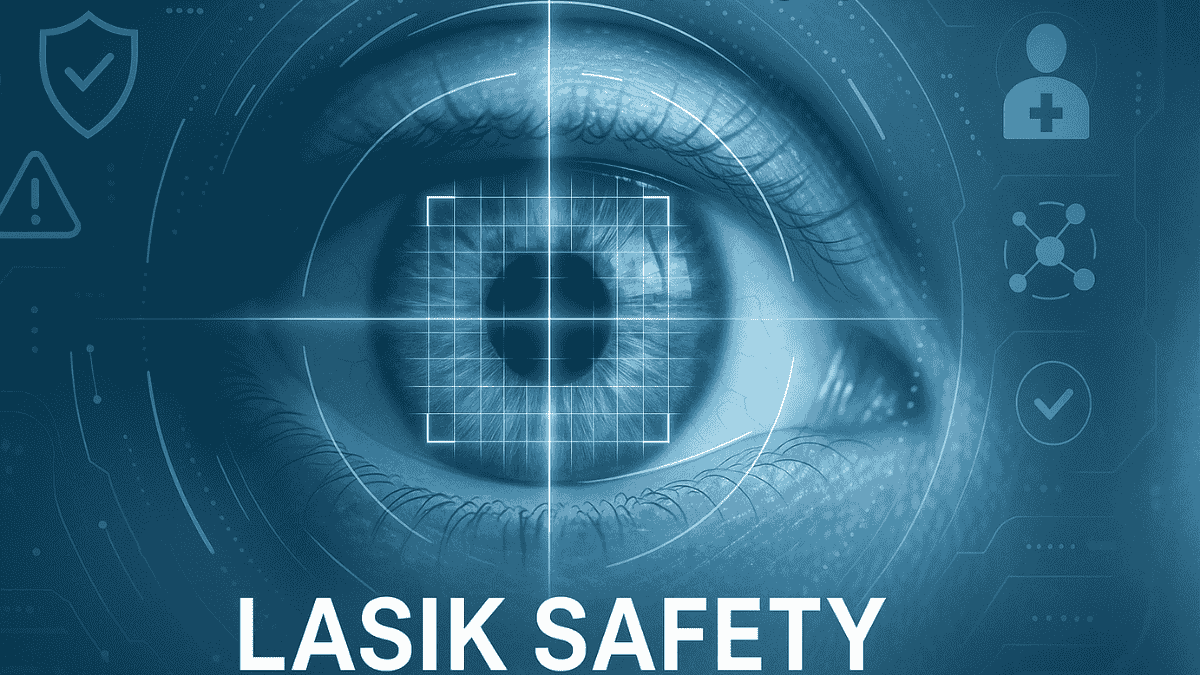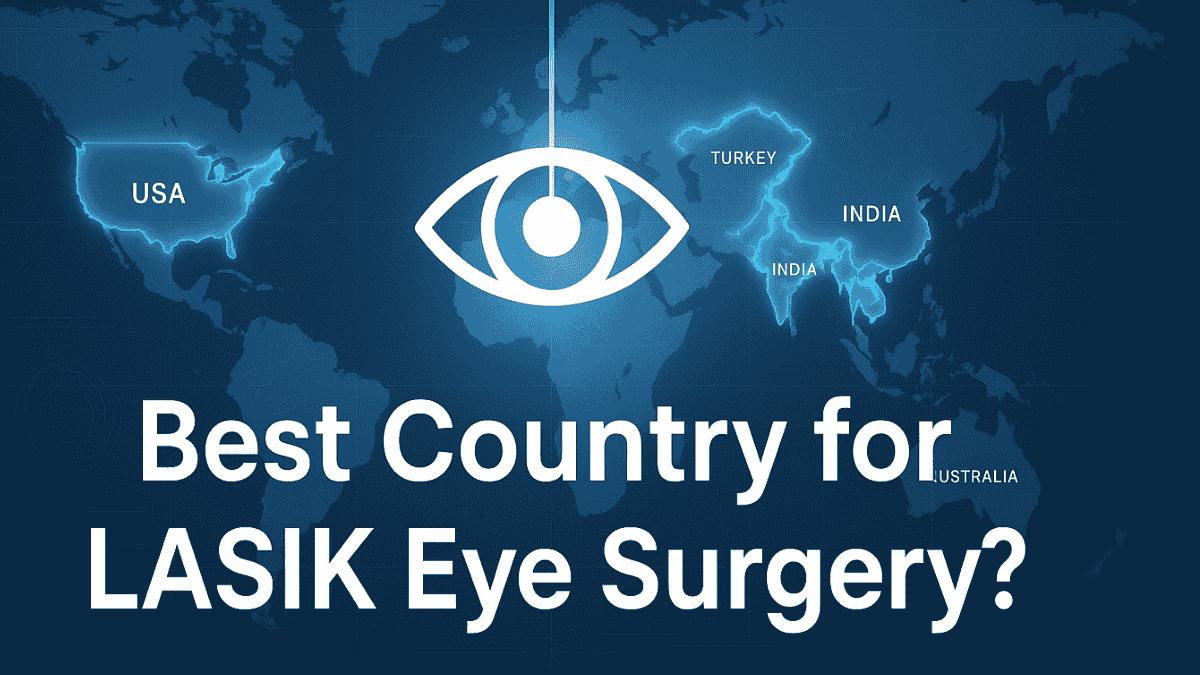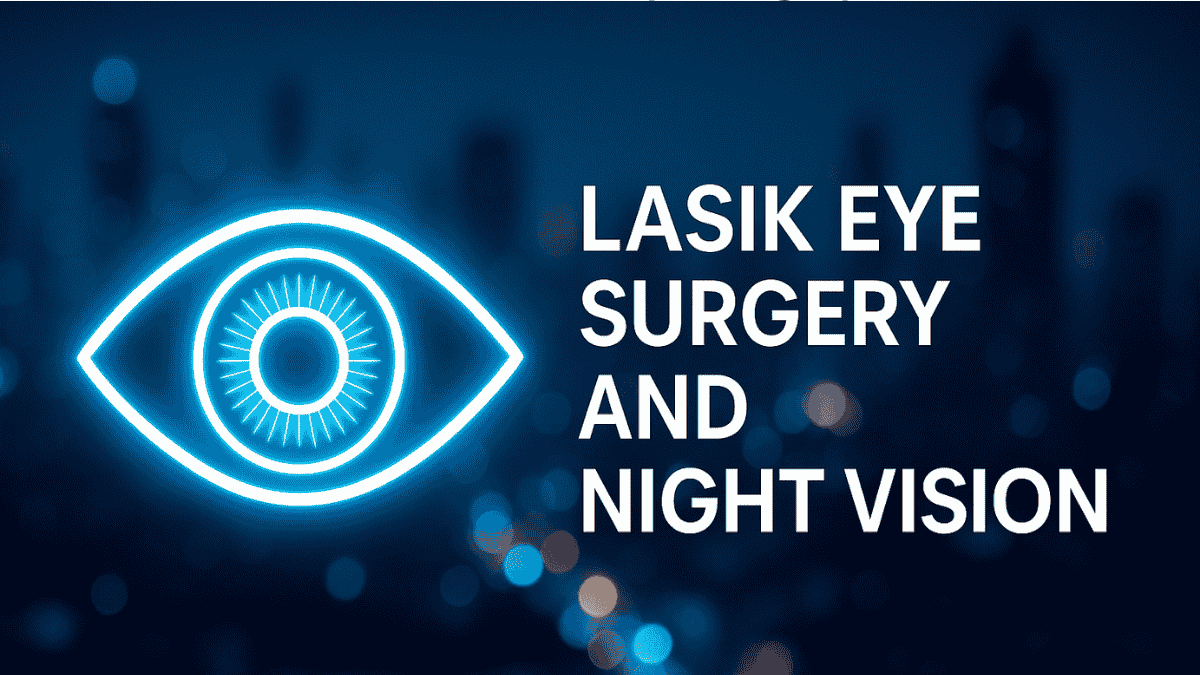
Concerns about lasik eye surgery night vision are common for individuals considering this vision correction procedure. You might be curious how the surgery could impact your ability to see clearly in low-light conditions. This article will explore the connection between LASIK and night vision, discuss potential vision problems, and offer information to help you make an educated choice.
LASIK, an acronym for Laser-Assisted In Situ Keratomileusis, is a surgical procedure that reshapes the cornea, the clear front part of the eye. This reshaping aims to correct refractive error conditions such as nearsightedness, farsightedness, and astigmatism. While generally safe and leading to improved vision for many, some patients notice changes in their night vision after undergoing lasik.
Table of Contents
Lasik Eye Surgery Night Vision: Changes After LASIK
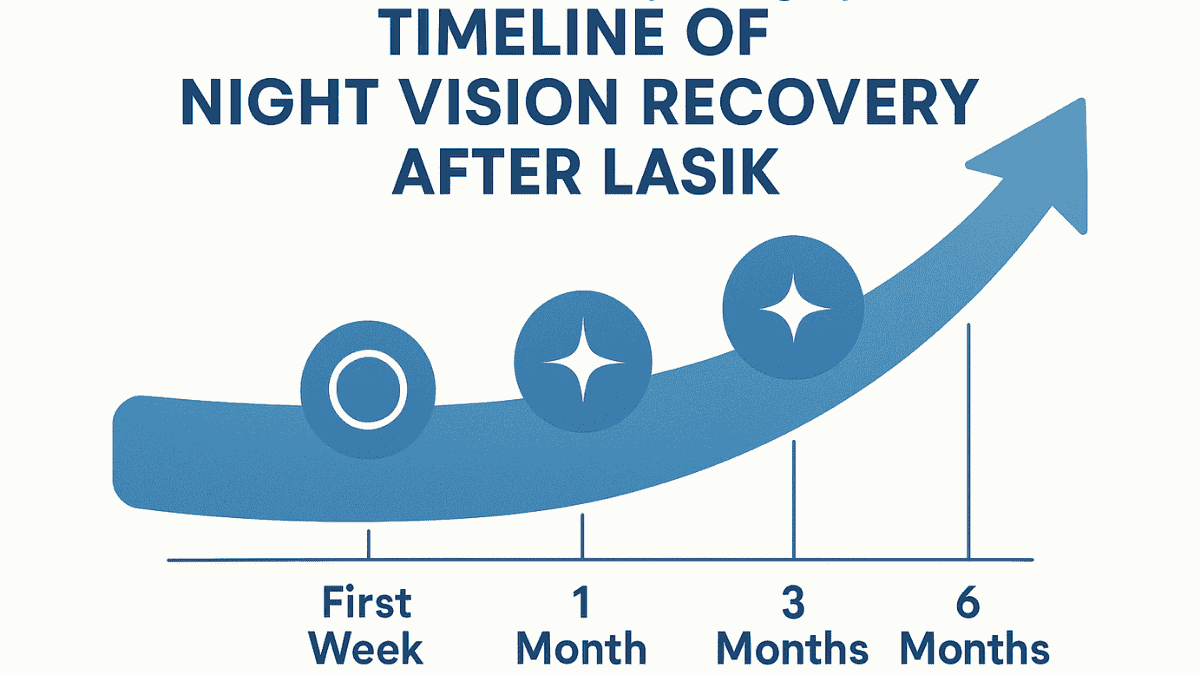
After undergoing lasik surgery, some individuals observe alterations in their night vision. These changes can manifest as halos around lights, increased night glare, or starbursts, which some describe as starbursts difficulty. It is important to understand that these effects are often temporary and typically improve as the eyes heal.
The corneal reshaping integral to laser eye surgery can occasionally lead to these visual disturbances. Your eyes require a period of adjustment to their new corneal curvature and focusing capability. Most patients discover that their night vision stabilizes within several weeks to a few months following the lasik procedures, though experiences can vary.
Patience during the post-operative care period is important as your eyes recover. Experiencing issues with lights difficulty is common initially, but for most, these vision disturbances diminish. Maintaining realistic expectations throughout this healing phase can greatly help.
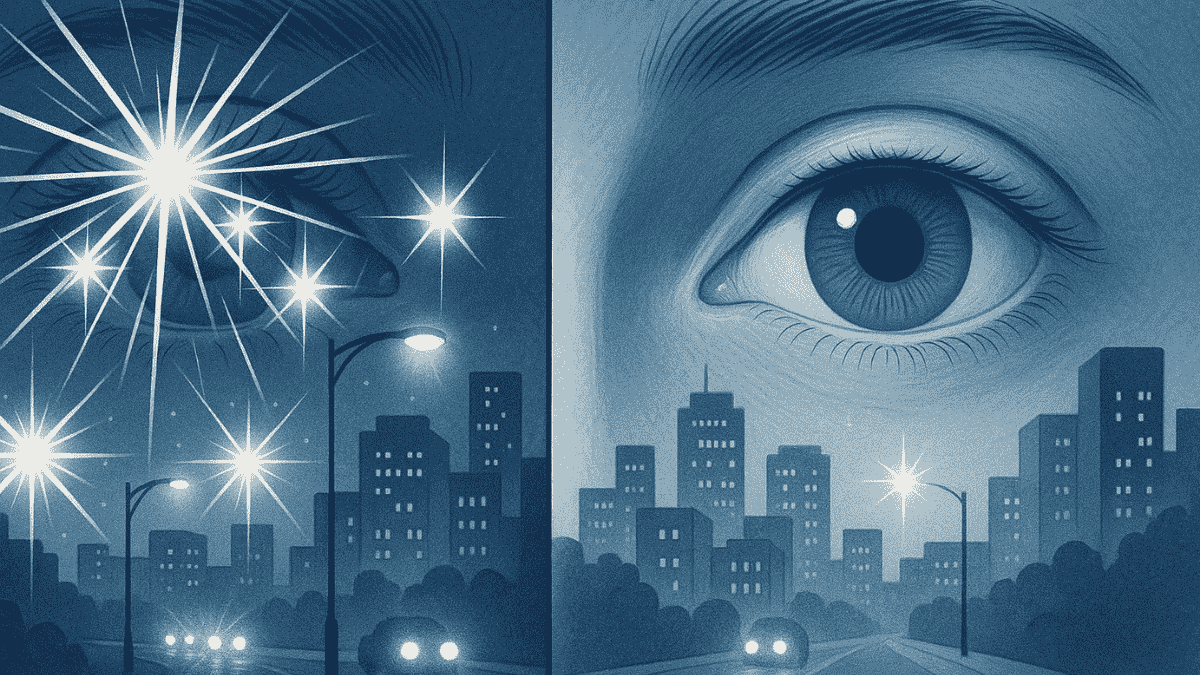
Common Night Vision Symptoms Post-LASIK
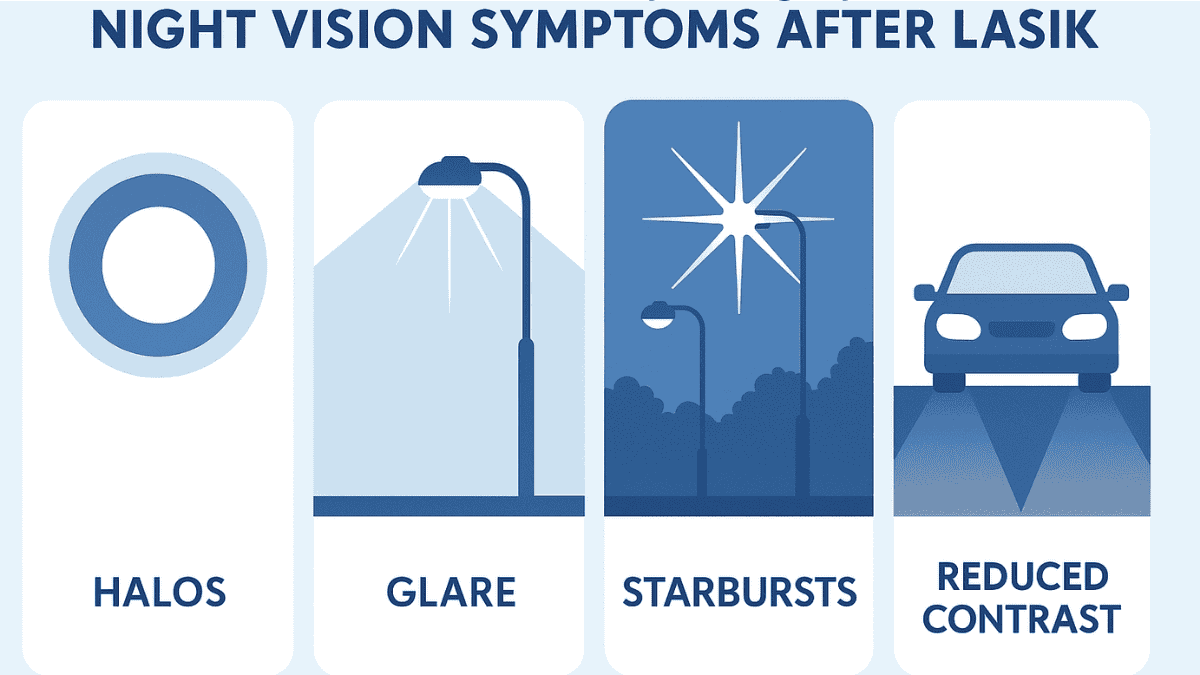
Let’s review the most frequently reported night vision problems following laser eye surgery. These symptoms can impact how you perceive your surroundings in dimly lit environments.
- Halos: These appear as circles of light around bright objects, such as streetlights or oncoming headlights.
- Glare: This is an increased sensitivity to bright lights, making it uncomfortable to look at light sources.
- Starbursts: These are rays or streaks of light that seem to radiate from light sources.
- Reduced contrast sensitivity: This refers to difficulty distinguishing objects from their background in low light conditions, impacting the ability to see subtle differences in shading and texture.
These symptoms can be more prominent when driving at night or navigating dimly lit spaces. However, it’s crucial to remember that many people experience these phenomena to some extent even without having had any eye surgery. If you are experiencing issues, consult your eye doctor.
The severity and duration of these night vision disturbances can vary from person to person. For some, they are a minor annoyance that fades quickly. For others, they might persist for a longer period, requiring more attention and management from eye care professionals.
Related Article
Blurry Vision After LASIK: What’s Normal?Factors Influencing Night Vision After LASIK
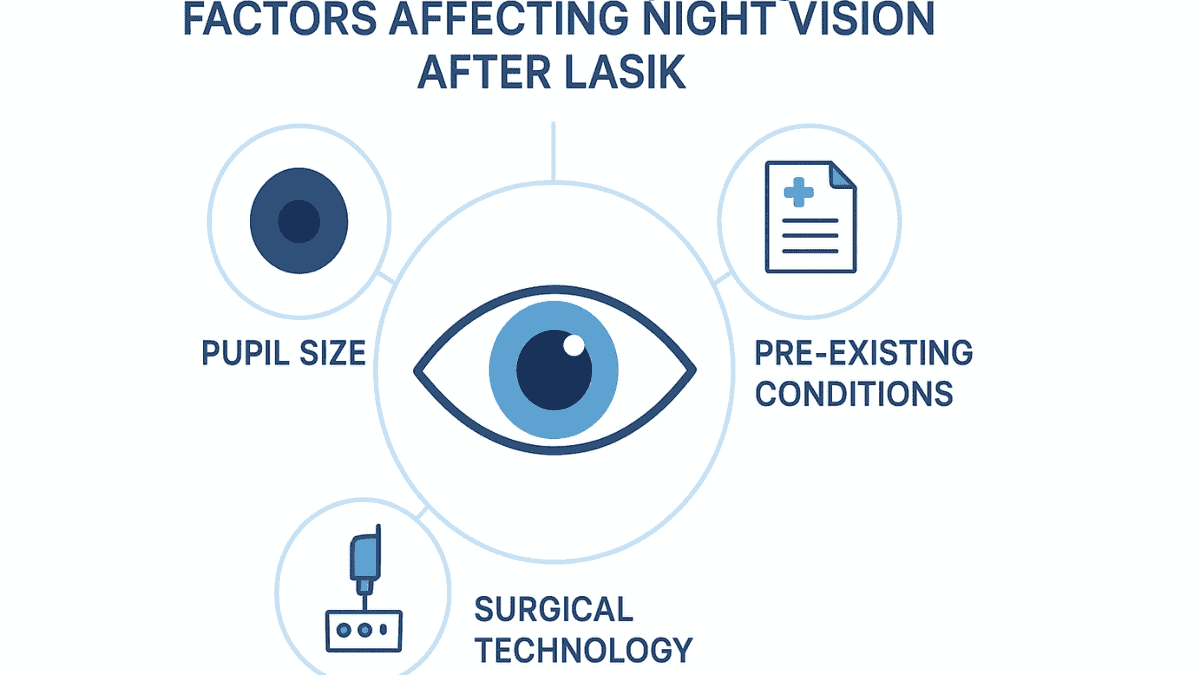
Several elements can affect your night vision quality after your laser vision correction with LASIK. Understanding these can help set realistic expectations for your visual outcome.
Pupil Size
Individuals with naturally larger pupils may be more susceptible to night vision problems. In low-light conditions, the pupils dilate (enlarge) to allow more light to enter the eye. If the cornea’s treated area, known as the optical zone, is smaller than the fully dilated pupil size, light passing through the untreated peripheral cornea can cause visual disturbances like halos or glare.
Pre-operative measurements of pupil size in dark conditions are an important part of the LASIK evaluation. Eye doctors use this information to plan the surgical procedure and counsel patients about potential risks. Advanced laser platforms often allow for larger treatment zones, which can mitigate this issue.
Pre-existing Conditions
If you experienced poor night vision before LASIK, perhaps due to a high degree of nearsightedness, farsightedness, or significant astigmatism, you might still encounter some night vision issues post-surgery. While LASIK aims to correct the underlying refractive error causing these problems, and often does improve night vision, it may not eliminate all pre-existing difficulties, especially if other factors like higher order aberrations were present.
Certain eye health conditions, such as early-stage cataracts or severe dry eye, can also contribute to poor night vision. A thorough pre-operative examination will assess overall eye health to identify any factors that could complicate the outcome. For instance, patients with a history of surgery glaucoma may need special consideration.
Surgical Technique and Technology
The specific LASIK technique and the technology employed can significantly impact night vision outcomes. Older laser systems, for example, might have been associated with a higher incidence of night vision disturbances compared to modern, sophisticated platforms. The way the corneal flap created during the procedure heals can also play a role.
Advanced technologies like wavefront-guided LASIK or topography-guided LASIK are designed to provide a more customized treatment. These custom lasik approaches map and address tiny imperfections in the eye’s optical system, known as higher order aberrations, beyond just the basic refractive error. By reducing these aberrations, such technologies can potentially lower the risk of developing new night vision problems and sometimes even improve pre-existing ones, leading to clearer vision.
Related Article
LASIK Eye Surgery Success StatisticsManaging Night Vision Issues After LASIK
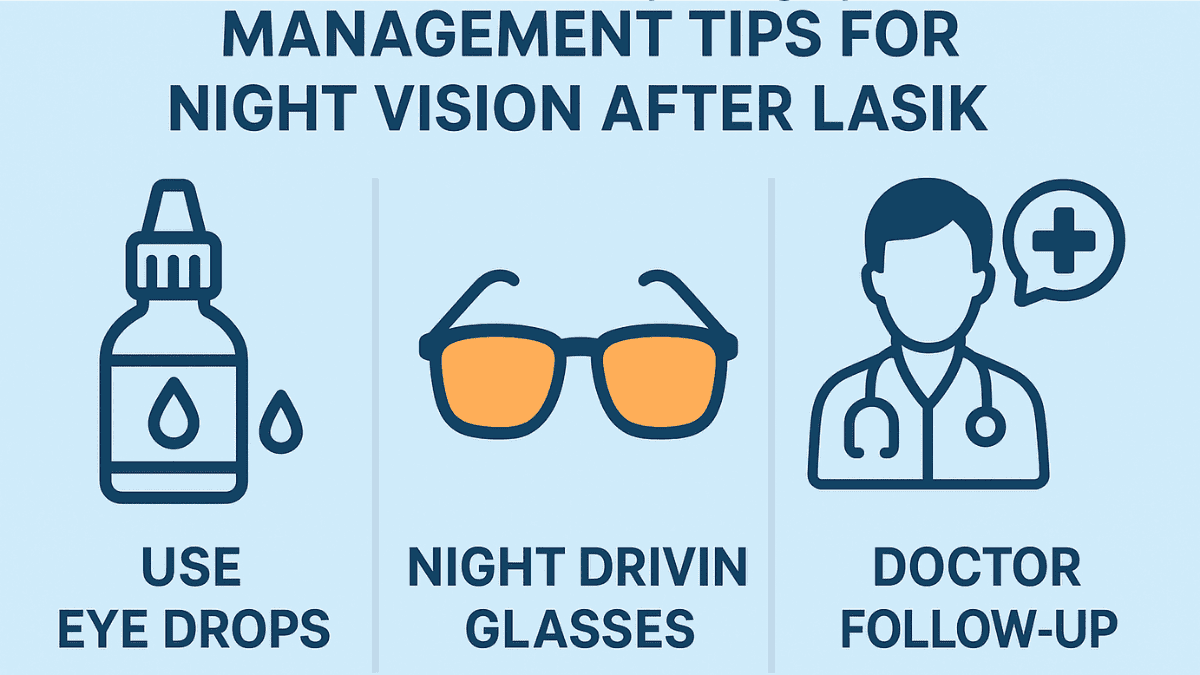
If you’re dealing with night vision problems after LASIK, try not to worry, as there are several strategies to help manage these symptoms and improve your comfort. Most issues related to poor night vision resolve over time.
Give It Time
Patience is a very important aspect of the recovery process. Many night vision issues, including halos and glare, diminish and often resolve on their own as your eyes heal and adapt to the changes from the laser eye surgery. The initial few weeks to months after the surgical procedure are when symptoms are typically most noticeable, and patients notice improvement gradually.
The corneal tissue remodels, and inflammation subsides during this period. This natural healing allows the optical quality of the eye to improve. Consistent follow-up appointments with your eye doctor will help track this progress.
Use Lubricating Eye Drops
Dry eye symptoms are common after LASIK and can significantly exacerbate night vision problems like blurry vision or increased glare. Using preservative-free artificial tears or prescribed eye drops frequently can help keep your eyes moist, stabilize the tear film, and may improve your vision quality, especially in dimly lit environments.
Your eye care professional might recommend specific types of eye drops based on your individual needs. Sometimes, more intensive dry eye treatments are necessary if the condition is severe. Keeping the ocular surface healthy is critical for good visual outcomes.
Related Article
Managing Dry Eye Syndrome After LASIKWear Night Driving Glasses
If you find night driving challenging due to glare or halos, consider using glasses specifically designed for night driving. These often have an anti-reflective coating and may have a slight yellow tint to enhance contrast sensitivity. They can help reduce the intensity of oncoming headlights and streetlights, making driving at night more comfortable and safer.
Consult your eye doctor before purchasing any specialized eyewear. They can offer recommendations based on your specific vision disturbances and needs. This small aid can make a big difference while your eyes continue to heal.
Follow-Up With Your Eye Doctor
Regular check-ups and follow-up appointments with your eye doctor or one of the eye care professionals are crucial after LASIK. They will monitor your healing progress, assess your vision, and address any persistent issues, including night vision problems. Open communication about any vision disturbances you experience is very important.
In some cases, if night vision problems persist beyond the typical healing period, your doctor might suggest further evaluation to check for residual refractive error or other contributing factors. Depending on the findings, additional treatments, such as enhancement procedures (a secondary LASIK procedure) or specific eye drops, may be recommended to fine-tune your vision and improve eyes comfort.
Advances in LASIK Technology and Night Vision
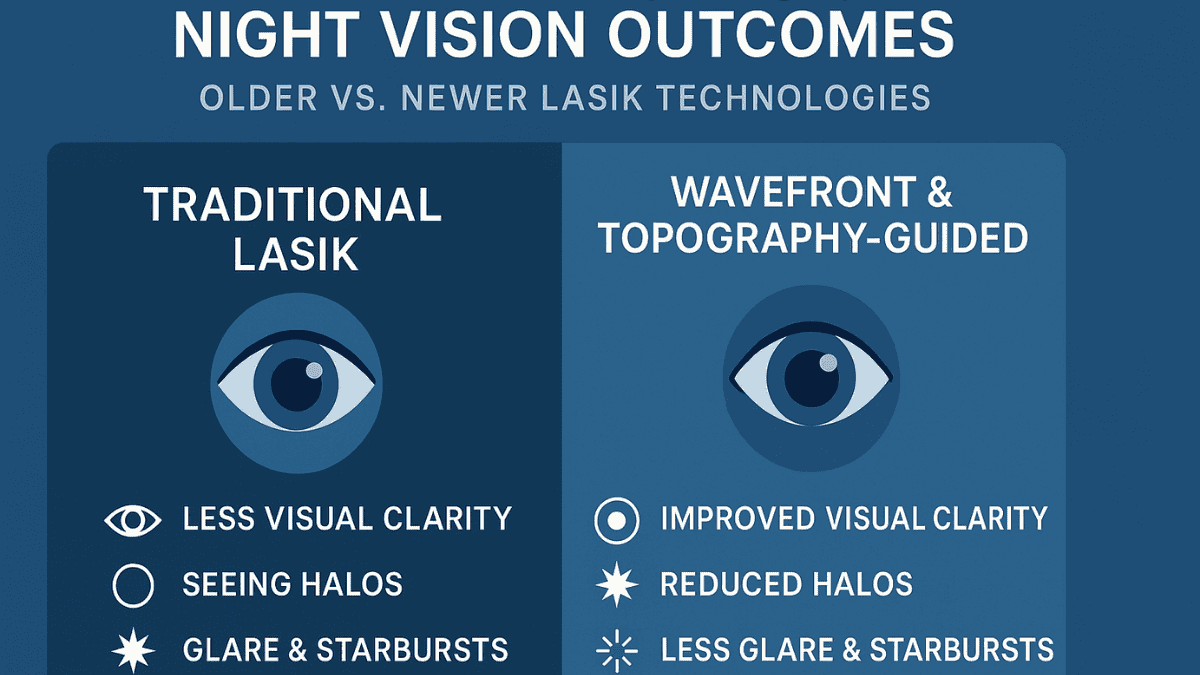
LASIK technology has significantly advanced since its inception, with modern techniques specifically aiming to minimize or prevent common night vision disturbances. These innovations offer patients a higher likelihood of achieving excellent vision quality, both day and night.
Wavefront-Guided LASIK
Wavefront-guided LASIK, often referred to as custom LASIK, uses advanced diagnostic technology to create a highly detailed three-dimensional map of your eye’s unique optical imperfections, including higher order aberrations. This map guides the laser in reshaping the cornea with exceptional precision, addressing subtle errors that standard treatments might miss. By correcting these specific imperfections, wavefront technology can reduce the risk of inducing new night vision problems like halos and glare and may improve overall visual acuity and contrast sensitivity, contributing to clearer vision.
This personalized approach considers the unique characteristics of each eye, moving beyond standard prescriptions for glasses or contact lenses. The goal is to create a smoother, more optically perfect corneal surface. This can lead to sharper vision, especially in low-light conditions.
Larger Optical Zones
Modern excimer lasers used in LASIK procedures can create larger optical treatment zones on the cornea. Treating a wider area of the cornea is particularly beneficial for individuals with larger pupils. A larger optical zone helps to ensure that when the pupil dilates in dimly lit environments, it remains within the fully treated area of the cornea, thus reducing the likelihood of light scatter and associated night vision problems such as halos and starbursts difficulty.
The size of the optical zone is often determined based on pre-operative measurements of pupil size in varying light conditions. Eye doctors aim to create a treatment zone that comfortably accommodates the patient’s largest pupil diameter. This thoughtful planning is a key part of modern LASIK procedures.
Topography-Guided LASIK
Topography-guided LASIK is another advanced form of custom laser eye surgery that uses detailed corneal mapping technology. This system measures thousands of points on the corneal surface to create a precise map of its curvature, much like a geographical map shows terrain. This detailed information guides the laser to smooth out irregularities on the cornea that may not be related to just the refractive error but can still affect vision quality, particularly night vision.
This technique is especially useful for patients with irregular astigmatism or other corneal abnormalities. By creating a more regular and uniform corneal surface, topography-guided LASIK can lead to significant improvements in visual acuity and a reduction in symptoms like light sensitivity and night glare. Many patient reviews highlight satisfaction with results from such advanced procedures.
What the Research Says About LASIK and Night Vision
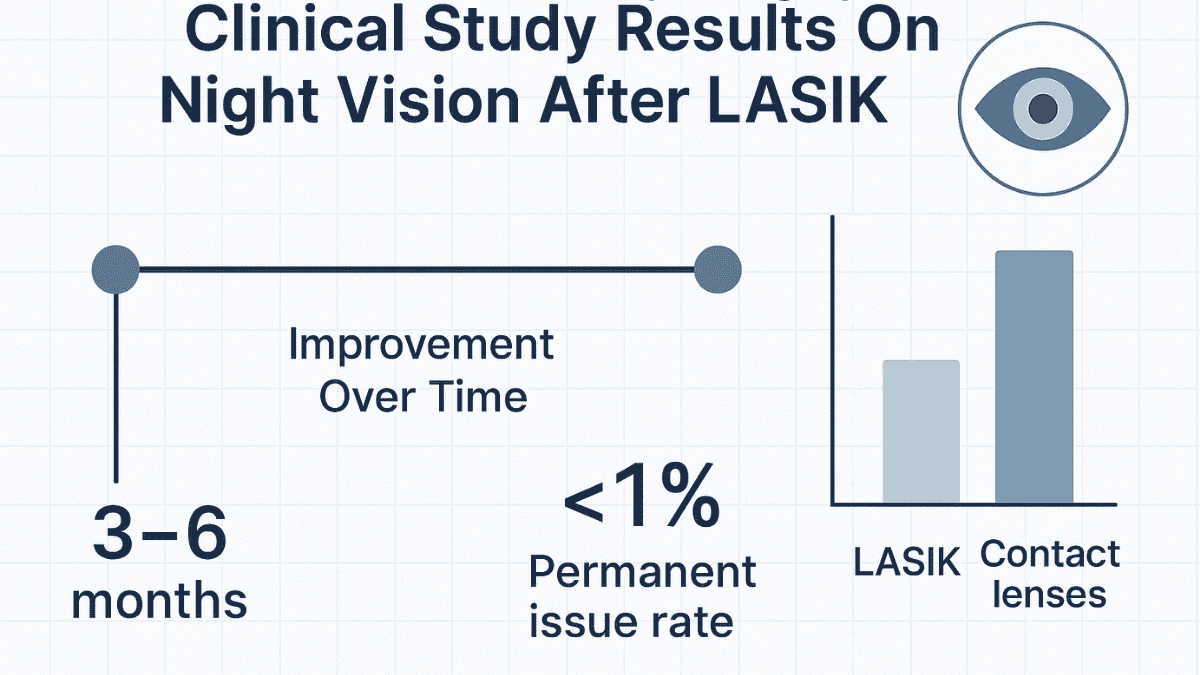
Numerous studies have investigated the impact of LASIK surgery on night vision, and the findings are generally encouraging, reflecting the advancements in technology and surgical techniques. A comprehensive review published in the Journal of Cataract & Refractive Surgery indicated that while some patients do experience initial night vision disturbances such as halos or glare, these symptoms tend to improve significantly or resolve completely over the healing period, typically within three to six months.
Another significant study featured in the Journal of Refractive Surgery reported that modern LASIK techniques, particularly those incorporating wavefront-guided or topography-guided ablations and larger optical zones, have substantially reduced the incidence of severe or persistent night vision problems. In many contemporary studies, the rate of patients experiencing troublesome permanent night vision issues is very low, often less than 1%.
Research also suggests that for many patients, especially those with high pre-operative refractive error, night vision quality can actually improve after LASIK compared to their vision with glasses or contact lenses. This is because LASIK can reduce optical imperfections that were present with corrective lenses. However, it’s important for patients undergoing lasik to have realistic expectations and discuss potential risks with their eye doctor.
Is LASIK Right for You? Understanding Candidacy and Expectations
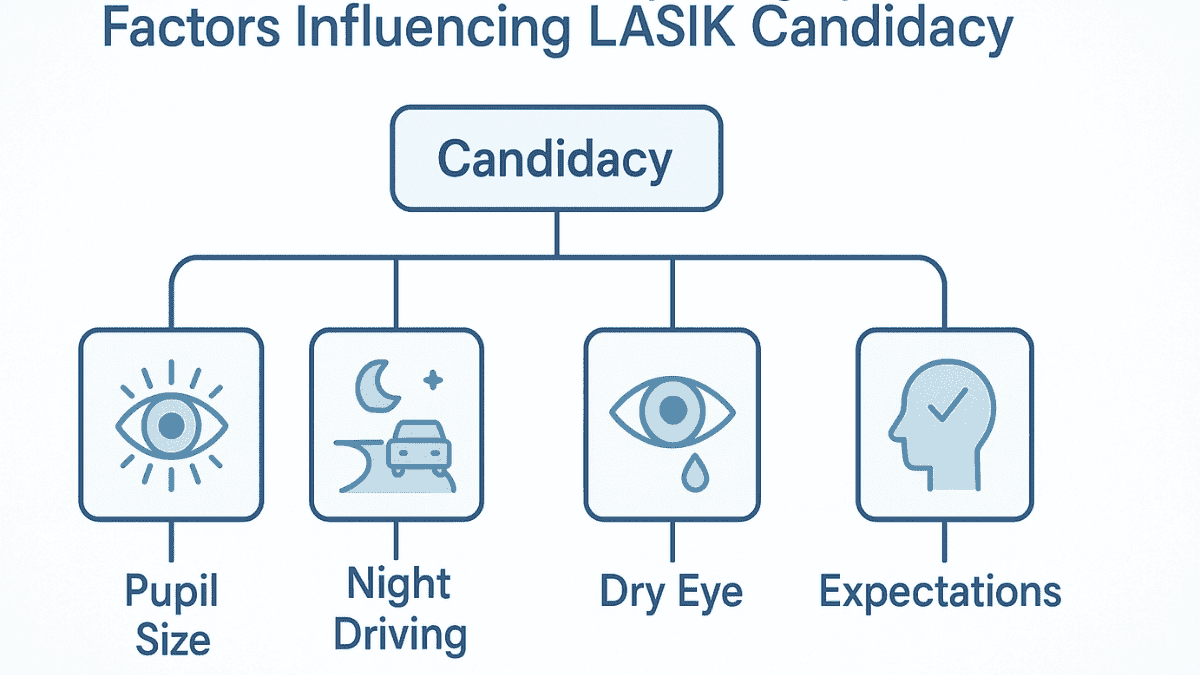
Deciding whether to undergo laser eye surgery is a significant personal choice that requires careful consideration of various factors. Your eye health, lifestyle, and vision goals all play a part in determining if LASIK is the most suitable vision correction option for you. Having realistic expectations about the outcomes, including potential effects on lasik night vision, is crucial.
Consider these points when evaluating LASIK:
- Your current vision problems and overall eye health: LASIK is effective for myopia, hyperopia, and astigmatism, but conditions like severe dry eye, thin corneas, or active eye infections might make you a less ideal candidate. A history of certain conditions, such as surgery glaucoma or keratoconus, also requires careful evaluation by eye doctors.
- Your lifestyle and vision needs, including night activities: If you frequently drive at night or work in dimly lit environments, discuss this with your surgeon. Understanding your visual demands helps in planning the procedure.
- Your comfort level with the potential risks and benefits: All surgical procedures carry some risk. Your surgeon should thoroughly explain potential complications, including temporary or, rarely, permanent night vision disturbances.
- Your expectations for the outcome: While LASIK offers the prospect of significantly improved vision and freedom from glasses or contact lens wear, it’s important to understand that perfect vision or elimination of all night vision issues is not guaranteed for everyone.
A comprehensive consultation with an experienced eye surgeon is the best way to weigh these factors. They will perform a detailed eye examination, discuss your individual risk profile, and help you make an informed decision about whether LASIK or another vision correction procedure can best help you achieve clearer vision.
Preparing for LASIK: Questions to Ask Your Surgeon About Night Vision
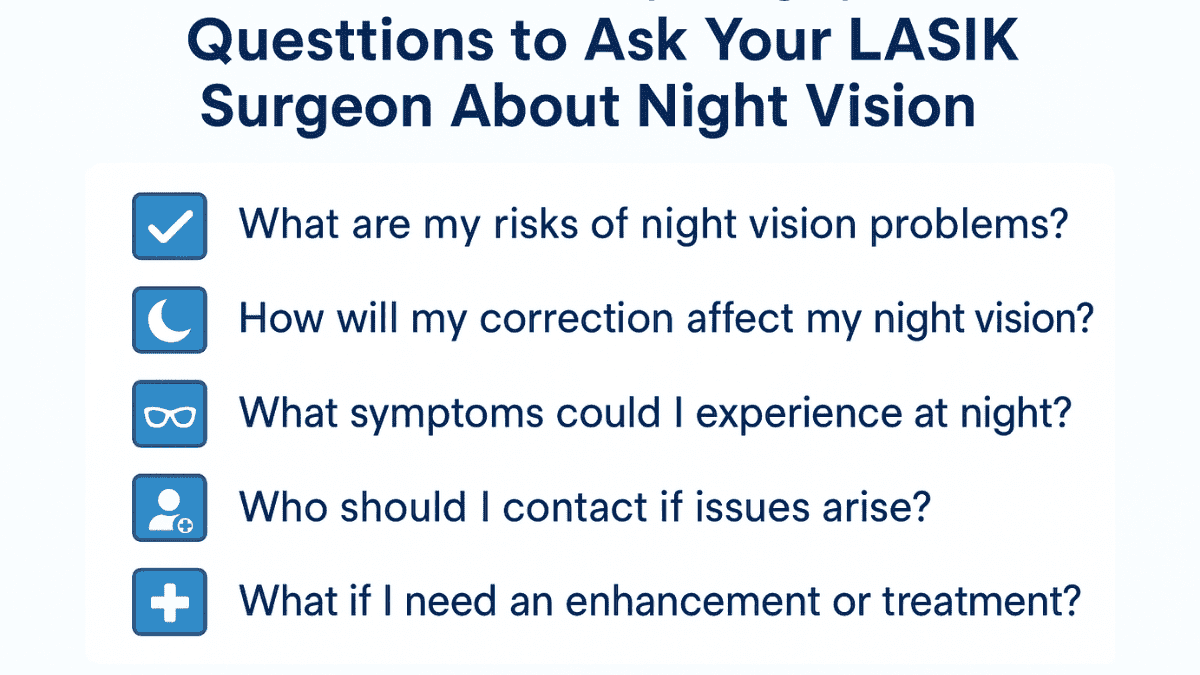
If you are considering LASIK, a thorough discussion with your eye surgeon is essential. Asking specific questions about night vision can help you feel more prepared and informed. Here are some important questions to pose during your consultation:
- Based on my eye examination and pupil size, what is my specific risk of experiencing night vision problems after the surgical procedure?
- If I do experience night vision issues like halos or glare, how long do these symptoms typically last for patients with profiles similar to mine?
- What specific laser technology and techniques (e.g., custom LASIK, wavefront-guided, larger optical zones) do you use to minimize the risk of night vision disturbances?
- How do you and your clinic manage persistent night vision problems if they occur after the eyes heal? Are there specific post-operative care protocols?
- Can you show me anonymized before-and-after results or share patient reviews from individuals with a similar refractive error and pupil characteristics to mine?
- Are there any pre-operative steps I can take to optimize my eye health and potentially reduce the risk of night vision difficulties?
- How does my age and current level of refractive error influence the likelihood of experiencing changes in my night vision?
Asking these questions will provide you with a better understanding of what to expect. An open dialogue with your eye care professionals builds confidence and helps in setting appropriate expectations for your improved vision.
Alternative Vision Correction Options
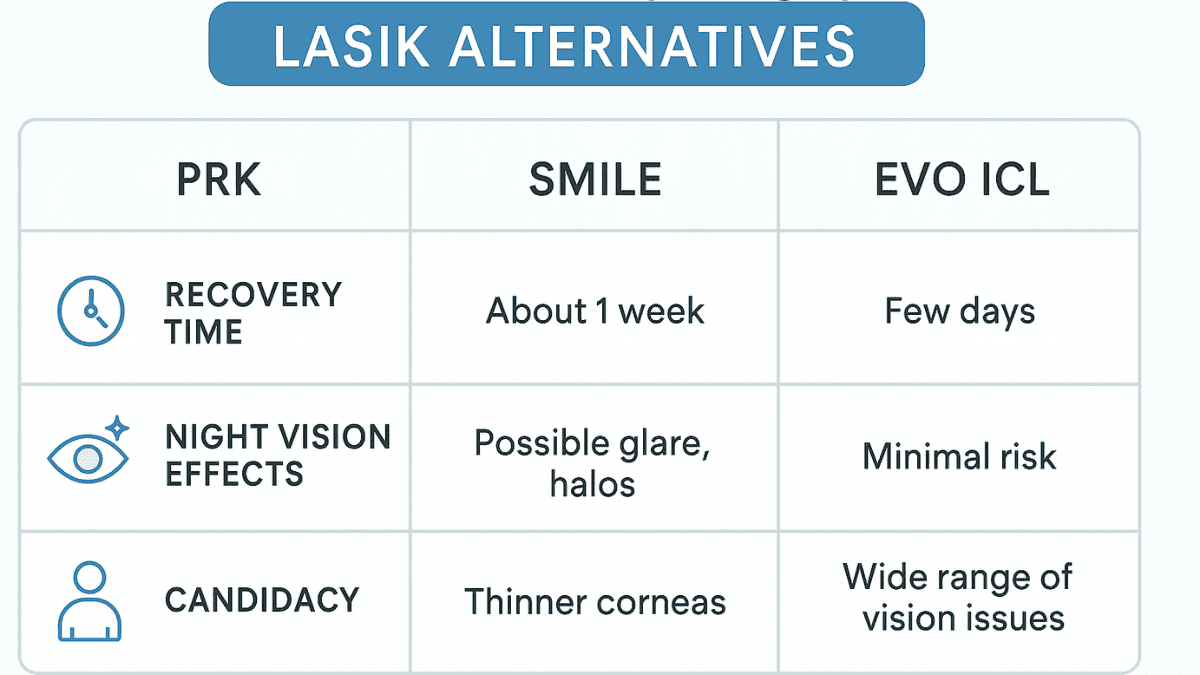
If you have concerns about potential night vision issues with LASIK, or if you are not an ideal candidate for the procedure, there are other effective vision correction options available. Each has its own set of benefits and considerations, especially concerning performance in low-light conditions.
PRK (Photorefractive Keratectomy)
Photorefractive keratectomy (PRK) is a type of laser eye surgery that reshapes the cornea, similar to LASIK. However, PRK does not involve creating a corneal flap; instead, the laser is applied directly to the surface of the cornea after the outermost layer (epithelium) is gently removed. Some studies and anecdotal reports suggest that PRK may have a slightly lower risk of inducing certain night vision disturbances, like halos or flap-related complications, for some patients, particularly those with thinner corneas or specific lifestyle considerations.
The healing process for PRK is generally longer and can involve more discomfort initially compared to LASIK. However, the long-term visual outcomes are comparable. Your eye doctor can discuss if PRK offers any advantages for your night vision based on your eye structure and needs.
Related Article
What to Know About PRK SurgerySMILE (Small Incision Lenticule Extraction)
SMILE is a newer, minimally invasive laser vision correction procedure. During SMILE, the surgeon uses a femtosecond laser to create a small, precise, lens-shaped piece of tissue (lenticule) within the cornea. This lenticule is then removed through a very small incision, typically less than 4mm, changing the corneal shape to correct the refractive error.
Because SMILE involves a smaller incision and no flap, it may offer benefits such as reduced incidence of dry eye symptoms and potentially faster recovery of corneal nerve sensation, which can influence night vision quality. Early studies on SMILE suggest good night vision outcomes, with some research indicating fewer induced higher order aberrations compared to traditional LASIK. It is a growing alternative for suitable candidates seeking freedom from their contact lens or glasses.
Related Article
SMILE Laser Eye Surgery ExplainedImplantable Contact Lenses (EVO ICL)
Implantable Collamer Lenses, such as the EVO ICL, are a type of intraocular lens that is surgically implanted inside the eye, typically between the iris and the natural crystalline lens. These lenses work like contact lenses, but they are placed internally to correct vision. ICLs can be an excellent option for individuals with high degrees of nearsightedness, farsightedness, or astigmatism, or for those with corneas that are too thin or irregularly shaped for laser-based procedures like LASIK or PRK.
Many patient reviews for EVO ICL highlight excellent night vision quality, potentially due to the lens’s design and placement, which can minimize issues like glare and halos often associated with corneal refractive surgery. Unlike laser vision correction, ICLs do not alter corneal shape and are also removable, offering a degree of reversibility. Other lens-based options include refractive lens exchange (RLE), which is similar to cataract surgery where the natural lens is replaced with an artificial intraocular lens; this is often considered for older patients or those with early cataracts. Some advanced lenses are even light adjustable post-surgery for fine-tuning vision.
Options like laser cataract surgery, which uses a laser for certain steps of the cataract removal, also involve an intraocular lens. While distinct from LASIK, understanding these alternatives can be helpful. Your eye care provider will explain if these procedures, or perhaps refractive lens exchange with a specific refractive lens, are more suitable for your eye health and vision goals.
Conclusion
LASIK eye surgery and night vision are intricately connected, but the relationship is not always a cause for major concern. While some patients may experience temporary changes in their vision in dimly lit environments or issues like night glare, many find these problems resolve as their eyes heal. Advances in LASIK technology, such as custom lasik and larger treatment zones, have significantly reduced the risk of persistent or severe night vision problems, leading to improved vision and fewer visual disturbances for many undergoing lasik.
If you are considering LASIK eye surgery, do not let anxieties about night vision deter you from exploring this potentially life-altering surgical procedure. Engage in a detailed discussion with an experienced eye surgeon or trusted eye care professionals, ask comprehensive questions, and make a choice based on your unique eye health, refractive error, and lifestyle needs. By seeking information from reliable sources, perhaps even reviewing a clinic’s patient education materials (which often cover aspects of their privacy policy regarding patient data and affirm that patient rights reserved are respected within their practice), you can feel more confident. With the correct approach and realistic expectations, LASIK can offer the promise of clearer vision day and night, potentially liberating you from the daily reliance on glasses or contact lenses and helping to improve eyes and overall quality of life. Remember that thorough post-operative care and attending all follow-up appointments are crucial for the best outcome.
FAQ
Halos and glare after LASIK are usually caused by light scattering due to changes in the corneal shape or healing process. These symptoms typically fade over time as the eye recovers.

Most night vision issues such as starbursts or reduced contrast sensitivity improve within a few weeks to six months after surgery, depending on individual healing.

Yes, LASIK may improve night vision for patients with high prescriptions or optical distortions from glasses, especially with advanced techniques like wavefront-guided LASIK.

Yes, patients with large pupils may experience more night vision issues if the treated corneal area is smaller than their dilated pupil in low light.

SMILE, a minimally invasive procedure, may cause fewer night vision disturbances than traditional LASIK due to its smaller incision and corneal preservation.

Yes, dry eyes can cause fluctuating vision, increased glare, and reduced clarity at night. Treating dryness often improves overall night vision.

Starbursts appear as radiating light patterns from bright sources. They’re common in the early LASIK recovery phase but often diminish over time.

Wavefront-guided LASIK customizes the treatment based on higher-order aberrations, helping reduce night vision problems like halos or reduced contrast.

Not always. While some patients report reduced contrast in dim settings initially, most recover normal sensitivity within weeks to months.

A larger optical treatment zone can reduce the chance of night vision problems by ensuring the treated area covers the dilated pupil.

Most patients experience temporary night vision disturbances, so night driving should be avoided until cleared by your eye doctor.

Yes, anti-reflective or contrast-enhancing glasses may help reduce glare and improve comfort when driving at night post-LASIK.

It’s rare. Most night vision problems are temporary. With advanced techniques, permanent issues occur in less than 1% of patients.

Studies show that night vision disturbances usually improve within 3–6 months. Modern LASIK methods lower the risk of lasting effects.

Patients with irregular astigmatism may be more prone to night vision issues. Topography-guided LASIK can help address this.



